10 Other Items To Carry In Your First Aid Kit
I have been asked more times than I want to admit, “What else would you carry in your first aid kit?” This question has arisen out of the post I wrote last year about how to make a $20 First Aid Kit…Yes. The core of my kit and always “gotta have gear” is in the $20 kit, but when I’m tasked for something bigger or there are more people involved in an event… well… there’s more.
It’s a short list, but these 10 Other Items To Carry In Your First Aid Kit will expand the basic $20 First Aid Kit…Yes. The $20 First Aid Kit…YES!!! covers bleeding at all levels and a variety of bigger issues. The 10 Other Items to Carry First in Your First Aid Kit is designed to expand the capabilities of the $20 First Aid Kit…YES!!! to include some of the more common issues like diabetic emergencies and the common stomach ache.
- Shemagh
- Tourniquet
- Israeli Battle Dressing
- Cake Decorating Frosting
- Peppermint Candy
- Pain Relievers
- Children’s Aspirin
- Chemical Ice Packs
- Moleskin
- Dental floss and wax
The Shemagh
I know what you are probably thinking right now. A shemagh is NOT a first aid tool. The shemagh is more and more the go-to tool for me in my first aid kit. The multiple uses of the shemagh vary widely and cover way more territory than should be covered into one blog post, particularly when limited to just a few paragraphs.
The shemagh is a fantastically flexible tool in the field of first aid. Obviously, it can be used for bleeding wounds regardless of the degree of severity, for cleaning a wound, or a sling, or other splint. The best use, as of late, has been as a cold compress for cooling burns.
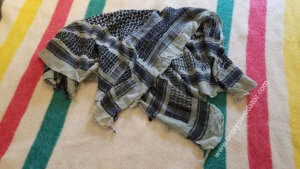
Shemagh for burns
In my experience, it works best to wet the shamagh until its almost drippy wet, but not quite drippy. Then fold it up so that it is just bigger than the burn. Once folded, simply put it on the burn. When it warms up to the touch on the burn, flip it over. It will cool off quickly on the side away from the skin while absorbing more heat from the burn. The compress cools the burn and removes heat at the same time. It takes a lot longer to cool a burn with a shemagh than it does with cold running water, but this compress can be a life saver if cold water is hard to come by.
I actually experienced this a couple of years ago at a scouting event. I had left my hat at camp during a rafting trip. My head was burnt pretty bad after about an hour and a half in the sun. When I got back to my car, I pulled my shemagh out and wet it down. In the hour and fifteen minutes it took to drive back to camp, using the process above, the heat was gone and there was no blistering or burning sensation. The best part was that there was none of the after effects of burning for days, blistering, and then peeling.
Tourniquet
The tourniquet is something that even 5 to 7 years ago, (this article is written in 2018), was not a particularly important item to carry. Now with the news streaming into our homes, there are every day events where people are killed or injured severely and are in need of immediate care. Unfortunately, there are not enough people properly trained to meet the need at this immediate care level. It is believed that many of these people could possibly have been saved if trained, equipped people were present. Training is a key to using the tourniquet properly. Here at www.bepreparedatoz.com we encourage people to get the training and certifications they need from recognized providers. (American Red Cross, Emergency Care & Safety Institute)
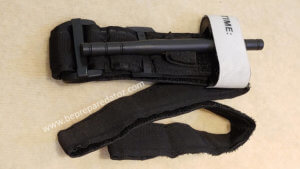
Note: If you ever have to apply a tourniquet, please make sure you tell the person you are applying the tourniquet to that it is going to be painful. This is important because the person that is bleeding may want to remove the tourniquet due to the pain.
Israeli Battle Dressing, (IBD)
The Israeli Battle Dressing is a fantastic tool for applying a pressure dressing. The IBD can be applied by a bystander or self applied one handed, if necessary. There are tons of videos and articles online detailing how to apply the IBD. Interestingly, this tool falls outside the basic training of most of the mainstream medical training organizations.
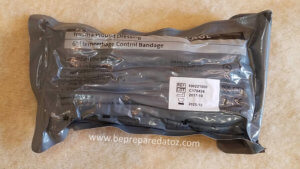
The IBD should be used with caution as it is very easy to apply the IBD too tightly. Properly used, it can control major bleeding. If it is used improperly, the IBD could have disastrous effects for the victim.
Cake Decorating Frosting
This is the small tube of gel frosting commonly used for writing messages on cakes and other bakery products. Frosting can commonly be used in the first aid realm for diabetic emergencies. This tool is simple to use and can be used to test blood sugar without the need for a tester. Ok, you won’t have numbers to get technical with, but you will be able to help the victim by knowing if their sugar is too low or too high until help arrives. The idea is to carry 2 of the smaller tubes. You give them one tube and wait to see if there is improvement in their condition after 5-7 minutes. If so, you give them the second one, because their blood sugar is too low. If there is no improvement, then you know their blood sugar is too high and they do not need more sugar.

Coaches may want to carry one or even two extra tubes of frosting for each person they know is diabetic on the team. The reason for this is that the athlete is using energy very rapidly due to the activity level they are performing at in whatever sport they are playing. It is important to have enough sugar to get them down off of this physical “high” and get back down to normal energy use levels.
Bonus: I have also been known to carry sugar packets that can be added to a bottle of water for easy delivery. This is an easy and cheap alternative to products made specifically for diabetic patients.
Peppermint Candy
It can be assumed that each of us has at one time or another had an upset stomach. We had food that was burnt or just didn’t settle well for one reason or another. We suffered because the usual remedies like Tums or Rolaids were not available. The heart burn with the upset was just tearing us up inside. Peppermint to the rescue! Those sweet little round discs of peppermint awesomeness can settle those sad tummies fairly quickly. I have found that, most of the time, one does the trick. Once in a blue moon you might need a second one, but this has been a rare experience for me.
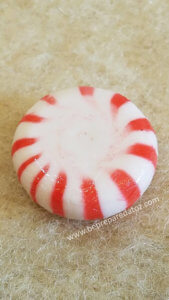
This works for the young people in your life, too! I serve as a scout leader for the Boy Scouts of America. I have found that when the scouts are away from home and the food is…um…questionable compared to what they are used to at home that generally a piece of peppermint goodness takes care of the issue.
Pain Relievers
Personally, I carry acetaminophen [note]McNicol, Ewan. “Ask The Professor.” Tufts Journal, Apr. 2008, http://tuftsjournal.tufts.edu/2008/04/professor/01/[/note] and ibuprofen [note]Pasricha, Shivam. https://www.quora.com/How-does-ibuprofen-work[/note] to relieve pain because they work in different ways. Acetaminophen blocks the pain and reduces fever while ibuprofen reduces swelling. Knowing the characteristics regarding these over the counter medications allows me to use them in different situations with the best effect.
A friend of mine has incredible knee pain from working for years on concrete floors. Most of that pain comes from swelling in the joints. He is constantly carrying some form of ibuprofen to relieve the pain. Acetaminophen products do not help him at all.
Children’s Aspirin
HEART ATTACK!!! Of course I would never recommend that anyone start a daily regimen of any medication without the direction of their personal doctor, but in the case of aspirin, that moment when you identify a possible heart attack, its use is probably warranted. Aspirin acts as a blood thinner and may help break up the clots causing a heart attack. The American Red Cross recommends the use of 4 specific questions before assisting with aspirin. Assuming the person is still conscious and can swallow, those 4 questions are:
■ “Are you allergic to aspirin?
■ Do you have a stomach ulcer or stomach disease?
■ Are you taking any blood thinners, such as warfarin (Coumadin™)?
■ Have you ever been told by a doctor to avoid taking aspirin?”[note]pg 33 https://www.redcross.org/content/dam/redcross/atg/PHSS_UX_Content/FA-CPR-AED-Part-Manual.pdf[/note]
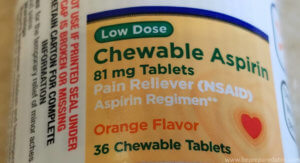
Chemical Ice Packs
These little gems are perfect for carrying in a go kit or backpack because they can be used at anytime. No refrigeration needed. I find myself at a lot of events like sports practices, games, or scouting venues where the availability of ice is limited to say the least. All you have to with these chemical ice packs is break the little bag inside and mix the contents thoroughly to have the cold you need short term until either EMS arrives and takes over or other decisions are made regarding the care needed for that particular situation. They are lightweight and can take a lot of abuse in that backpack or first aid kit.
I don’t carry these all year, because I live in a part of the country where 4-6 months out of the year there can be snow and/or ice available outside naturally. (You gotta love winter!)
Moleskin
This material is simply used for padding. I use it specifically to work with blisters, but knowing that it is flexible and thick makes it a valuable addition to either a first aid kit or any “emergency” bag. To start, using the shears in the $20 First Aid Kit…YES!!!, cut the moleskin to be about twice the size of the blister. Then cut a hole just slightly bigger than the blister so that the moleskin fits around the blister. Make as many of these pads as needed, stacking them up to be about one layer thicker than the blister. Apply them to the effected area by removing the paper backing and sticking them to each other and building up around the blister.
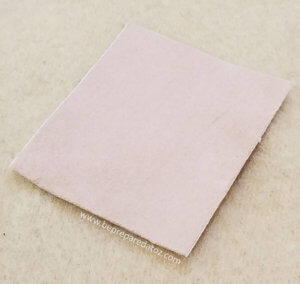
Once the moleskin is applied, it is good to go over it with either athletic tape or duct tape. The benefit of duct tape is that whatever is rubbing to cause the blister will slide across the padded blister without causing more damage.
Dental Floss and Wax
Dental floss can be used for several important tasks. First, floss can be used for the obvious use of cleaning between teeth. Floss can be used for other things as well. Your imagination is the only limiting factor. For example, I make homemade single use coffee bags for friends. In a pinch, dental floss works to tie things together or to hang things when other strong rope or paracord is not available. Dental floss can also be used to tie gauze pads together in a roll to help support an embedded object. This is certainly not a complete list of uses, but hopefully it serves to get your creative juices flowing.
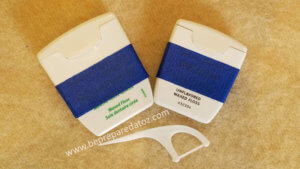
The dental wax in my kit is used for one thing… dental issues. An orthodontic brace and wire that has cut a lip and is rubbing…No Problem! Applied generously, dental wax that is formed to the brace in question should protect the inside of the lip from further damage. A lost or broken crown can be temporarily filled or covered with wax to relieve some of the pain until medical assistance can be obtained.
Note:
This article is written for informational purposes only! It is reasonable to expect that readers of this article will seek out proper training in the use of these or any other first aid measures. Nothing in this article is designed to be or to be considered/construed as medical advice.
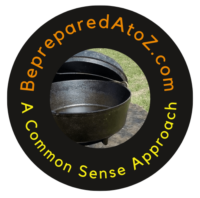
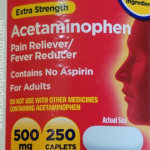
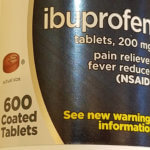
Absolutely great info as usual. Been keeping my 2 eyes open for this in Fort Walton Beach Fl. Thank you for your helpful hints, bless you, May Yeshua and the Living Word always be with you.
Thanks, Lisa! We strive to provide helpful hints wherever possible. Blessings to you as well.